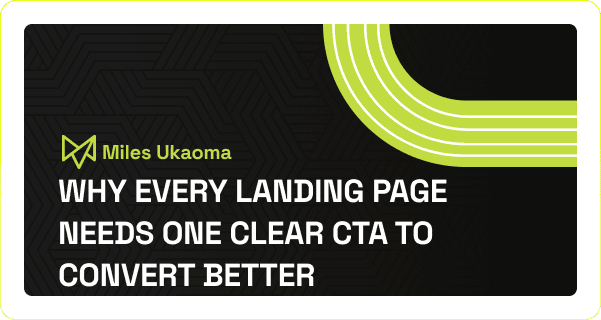Still wondering why your landing page isn’t converting, even though it looks polished?
You’ve dialed in the design. The copy sounds sharp. Maybe you've got a handful of calls to action: “Download the Guide,” “Book a Demo,” “Follow Us.” It feels like you're offering choices. But if you're seeing more bounce than clicks, the problem might be all those choices.
Some folks think giving users multiple paths is helpful. Others swear by keeping it tight: one goal, one action. One approach feels flexible. The other feels focused. The truth? Visitors don't want to decide—they want you to decide for them.
In this article, we’ll go over why one strong CTA works, how mixed signals undo your message, and how clarity can become your biggest conversion driver. By the end, you’ll know how to build landing pages that guide users exactly where they should go.
What Does “One CTA” Look Like in Practice?
Your landing page should do one thing well: get users to take the action you care about most. That means no side quests—just one direction. Below, we’ll walk through what happens when your message gets split and how to fix it so more of your traffic turns into results.
1. One Page Should Have One Job
Adding multiple objectives to one landing page only makes it harder for users to say yes.
People click through from an ad because they expect a very specific next step—maybe it’s downloading something, starting a trial, or signing up. But when they land and see “Sign Up,” “Book Demo,” and “Watch Webinar,” they freeze up. If the next step isn’t obvious, users leave.
Before you design anything, confirm the single goal your landing page should accomplish. If it’s lead generation, then social buttons and unrelated offers only get in the way. A focused page converts better because it's friction-free.
Every part of your page should support that one goal—or you probably don’t need it.
2. Multiple CTAs Create Noise
When you give people too many options, nobody wins.
You've seen it before: a landing page with four different CTAs—“Book a Call,” “Try Free,” “Download the PDF,” “Subscribe.” It doesn’t feel helpful. It feels scattered. All those buttons compete for attention, and none of them win. The message winds up diluted.
Instead, choose the one CTA that lines up best with where your visitor is in their journey. If someone clicked on a top-of-funnel ad, show them a free guide—and make that the only thing on the page worth doing.
If visitors can’t figure out what to click in the first three seconds, most won’t click anything at all.
3. More Choices, Fewer Actions
When it comes to CTAs, more isn’t better—it’s usually worse.
Hick’s Law nails this perfectly: the more options you give, the slower people decide. A long list of CTAs might feel like you're showing value, but really you’re adding confusion. Even too many “good” options can cause hesitation.
The best landing pages win because they’re simple. One button color. One message at the top. One clear visual path. Every new option introduces a wobble in the user’s brain. Get rid of that friction.
If someone pauses to think, there’s a good chance they’re gone.
4. Teardown Example: Overload vs. Focus
Here’s a page that misses the mark: a giant hero section pitching a webinar, a side panel pushing newsletter signups, and a footer packed with outbound links. It’s confusing, and it sends people in different directions.
Now contrast that with a winning version: headline, subheadline, and a single offer front and center. Button above the fold. Same CTA halfway down. No nav bar. No footer. Just a straight shot from interest to action.
Your landing page is not your website. Don’t treat it like one. Strip it down until only the essentials are left.
Clarity converts. Clutter distracts.
5. Clear Beats Clever Every Time
Design and copy aren’t there to look good—they’re there to make decisions easier.
The best landing pages speak to three things right away: something the user struggles with, the upside they want, and how to get there. Hit that trifecta hard. Your CTA should show up early and often—not hidden in the final paragraph.
Use whitespace to steer the eye. Keep your structure scannable. Don’t try to win design awards—just guide people where they need to go.
Clean copy paired with clear layout always wins over anything fancy for the sake of it.
6. Quick Checklist for High-Converting Pages
Ask these three things about every landing page you launch: Who’s it for? What’s the benefit? What’s the next move?
✅ Only one CTA—no multiple exit points✅ Repeat that CTA at natural scroll depth
✅ Everything speaks to one audience’s problem
✅ Headline promises immediate value
✅ The next step is obvious: form, calendar, or download
If a section doesn't push users toward your one goal, cut it out.
Simple Pages Win. It’s That Straightforward.
The highest-performing landing pages don’t try to be everything. They zero in on one action and make it impossible to miss. No distractions. No detours. Just a clear message and an easier decision.
Want Better Results? Pick One CTA and Stick With It
Trying to do too much is what keeps landing pages from converting. The best approach is to give users one job and make it incredibly easy to say yes. That’s when the numbers start moving.
Here’s your next step: review your top traffic page and delete anything that doesn’t push toward your primary CTA. Then A/B test the focused version. You’ll be surprised what happens when you take the clutter out of the path.
Need help building a landing page that gets real results? Schedule a call today and let’s turn that traffic into action.

.png?width=520&height=294&name=The%20Velocity%20Framework_%20How%20to%20Integrate%20Marketing%2c%20Websites%2c%20and%20AI%20Into%20One%20Growth%20Engine%20(1).png)



